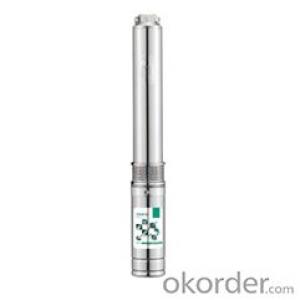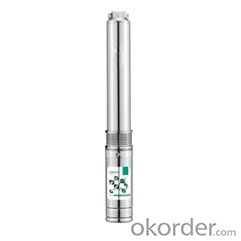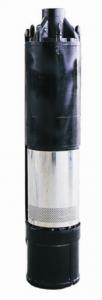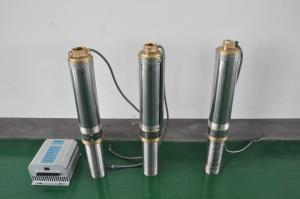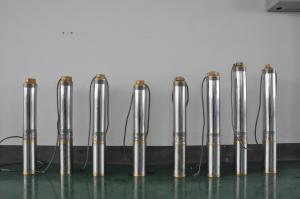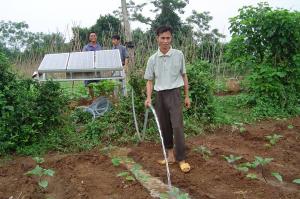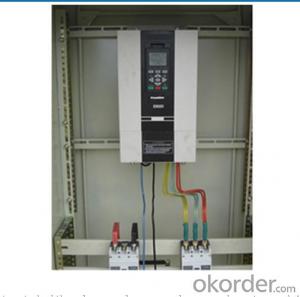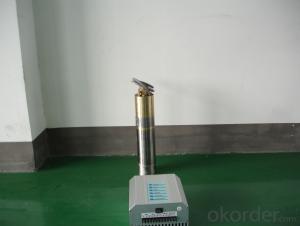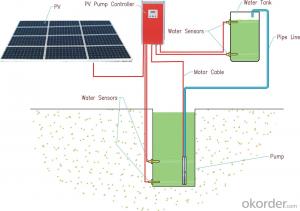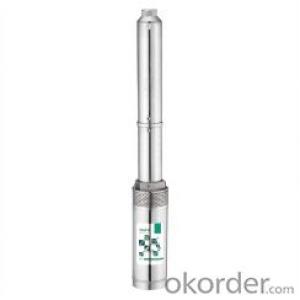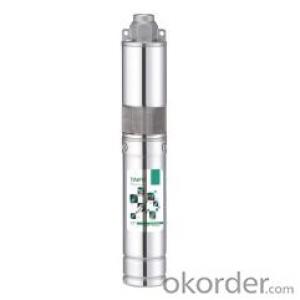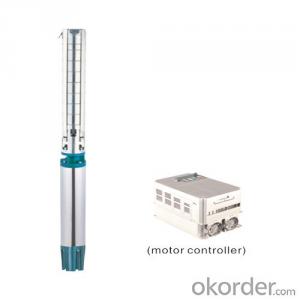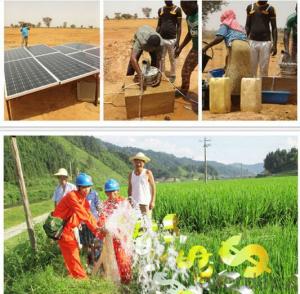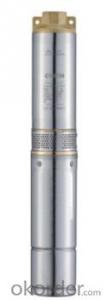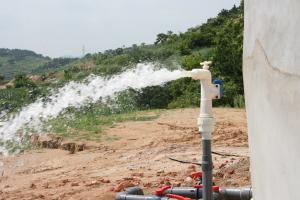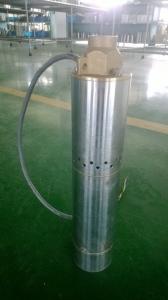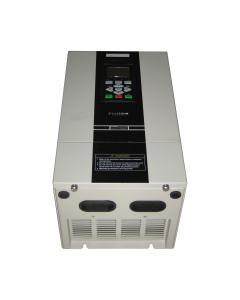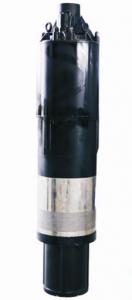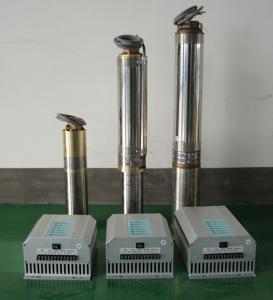4tsc Solar Pump Stainless Steel CE, Solar Panel - Solar Pump BP200
- Loading Port:
- Shanghai
- Payment Terms:
- TT OR LC
- Min Order Qty:
- 50 pc
- Supply Capability:
- 100000 pc/month
OKorder Service Pledge
OKorder Financial Service
You Might Also Like
1.APPLICATION AREA:This project products are mainly used in dry region for irrigation of agriculture, It can be used for drinking water and
living water. The living condition could be much improved. It also can be used for fountains.2.MATERIAL OF PARTS:Outlet: stainless steel
Pump body: stainless steel
Motor body: stainless steel
Bearing: C&U
3.ADVANCED TECHNOLOGY:1.Application innovation
Compared with the traditional alternating current machine, the efficiency is improved 25% by the permanent magnetism, direct current, brushless, non-sensor motor.
2.Technics innovation
Adopt double plastic package for rotor and stator, motor insulation≥300MΩ, the motor security was much improved.
3.Structure innovation
Oil filling, convenient installation and environmental protection4.HIGHLIGHTSa.Energy-saving and environment-protected green products
b.High technique products adopting MPPT and DSP chip technique.
c.100% copper wire, cold-rolled silicon steel sheet
d.CE certificate
e.Advanced three phase brushless DC motor
f.Stainless steel 316 screws
g.3 years warranty5.PRINCIPLE OF OPERATION:Solar panel collects sunlight→DC electricity energy → solar controller(rectification,stabilization,amplification,filtering)→available DC electricity→(charge the batteries)→pumping water6.ADVANTAGES OF SOLAR PUMP SYSTEM:A.It is easier and more widely used than any other dynamoelectric driven pumps.
B.It is more economical and more environmentally friendly.7.MODEL SELECTION:a.The power of solar panel = power of pump ×1.3
The voltage of solar panel = the voltage of pump
The controller should be matched
b.Select the batteries according to the following formulas:
The use hour of battery =
The battery capacity ÷(the machine power÷the battery voltage)×0.6 For example,the machine power is 200W, the battery
capacity is 100AH,the voltage is 12V,and the battery is fully charged,then the use hour is:100÷(200÷12)×0.6=3.6hours
c.The battery capacity=
the use hour ÷0.6×(the machine power÷the battery voltage) For example,the machine power is 200W,the battery voltage
is 12V,and the battery need to be used for 3.6hours,then the battery capacity is:3.6÷0.6×(200÷12)=100AH
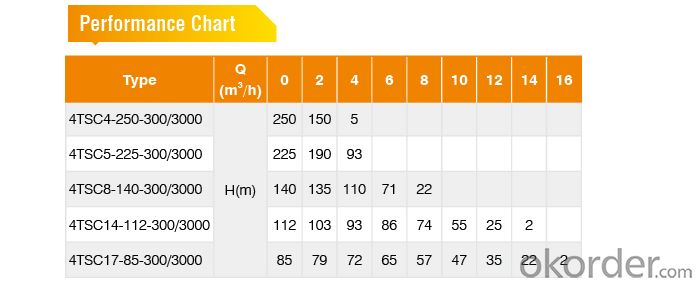

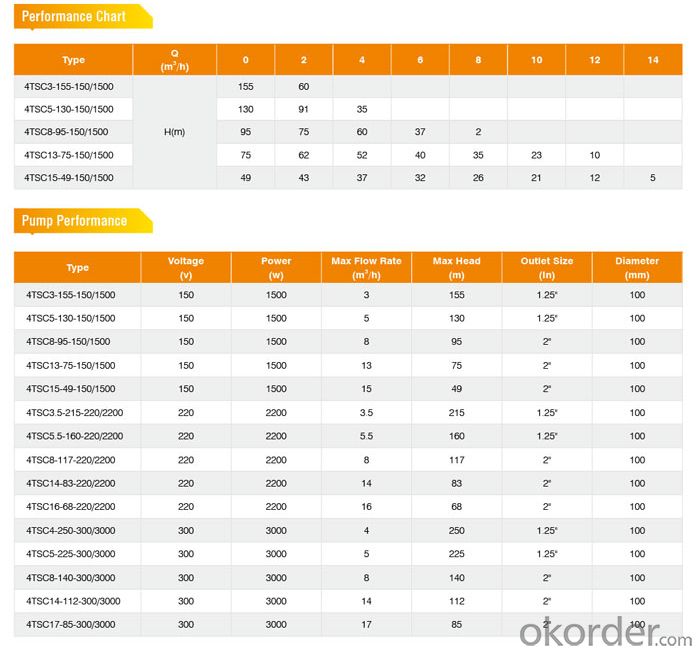
- Q: What is the expected energy payback time of a solar pump system?
- The expected energy payback time of a solar pump system varies based on multiple factors such as the efficiency of the system, the location's solar irradiation, and the specific application's water demand. On average, solar pump systems have an energy payback time ranging from 2 to 7 years, meaning that within this period, the system generates enough energy to offset the energy used in its production and installation.
- Q: Can solar pumps be used for water supply in arid or desert regions?
- Yes, solar pumps can be effectively used for water supply in arid or desert regions. Solar pumps use energy from the sun to power the water pumping system, making them a sustainable and practical solution for areas with abundant sunlight. They can extract water from boreholes, shallow wells, or even from rivers or lakes, and provide a reliable source of water for irrigation, livestock, or domestic use in arid or desert regions where traditional electricity supply may be limited or unreliable. Additionally, solar pumps offer an environmentally friendly alternative, reducing dependence on fossil fuels and contributing to the conservation of natural resources.
- Q: How does a solar pump help in reducing the use of irrigation water?
- A solar pump helps in reducing the use of irrigation water by using solar energy to power the pump, eliminating the need for electricity or fuel. This makes it a sustainable and cost-effective solution for farmers and agricultural practices. Additionally, solar pumps can be set up in remote areas without access to electricity, enabling efficient irrigation and reducing dependence on traditional irrigation methods that consume more water.
- Q: Can a solar pump be used for water supply in off-grid farms?
- Yes, a solar pump can definitely be used for water supply in off-grid farms. Solar pumps are an excellent alternative to traditional fuel-powered pumps in remote areas where there is no access to electricity. They harness energy from the sun and convert it into power to pump water from a well or a water source to the desired location. Solar pumps have several advantages for off-grid farms. Firstly, they are cost-effective as they eliminate the need for fuel, reducing operational expenses in the long run. Additionally, solar pumps require minimal maintenance compared to fuel-powered pumps, which reduces downtime and increases productivity on the farm. They are also environmentally friendly, emitting zero greenhouse gas emissions and reducing the farm's carbon footprint. Moreover, solar pumps can be customized to suit different farm sizes and needs. They come in various sizes and power capacities to cater to small-scale farms as well as large agricultural operations. Solar pumps can efficiently pump water for irrigation, livestock watering, and other farm-related activities, ensuring a sustainable and reliable water supply even in remote areas. However, it is essential to consider certain factors when installing a solar pump for water supply in off-grid farms. The size of the solar panel and battery bank should be calculated based on the water demand and the available sunlight in the area. Additionally, proper installation and regular maintenance are crucial to ensure the optimal performance and longevity of the solar pump system. In conclusion, solar pumps are an excellent choice for water supply in off-grid farms. They offer a sustainable, cost-effective, and environmentally friendly solution, ensuring a reliable water source for irrigation and other farming activities.
- Q: Are there any government subsidies or incentives available for installing solar pumps?
- Yes, there are government subsidies and incentives available for installing solar pumps. These vary from country to country and may include grants, tax credits, reduced interest rates on loans, and feed-in tariffs. It is recommended to research specific local or national programs to determine the eligibility criteria and benefits provided.
- Q: How much water can a solar pump produce?
- The amount of water a solar pump can produce depends on various factors, such as the size and capacity of the pump, the amount of sunlight available, and the depth and quality of the water source. Generally, solar pumps can produce anywhere from a few hundred liters to several thousand liters of water per day.
- Q: How does the size of the storage tank affect the performance of a solar pump?
- The size of the storage tank plays a crucial role in determining the performance of a solar pump. A larger storage tank allows for greater storage capacity, which in turn enables the pump to operate for longer durations. This is especially important during periods of low sunlight or at night when the solar panels may not be able to generate sufficient power to run the pump in real-time. With a larger storage tank, excess solar energy generated during peak sunlight hours can be stored and utilized later when needed. This ensures a continuous and consistent water supply, even in the absence of direct sunlight. On the other hand, a smaller storage tank may lead to frequent interruptions in water supply, as the pump may run out of stored energy quickly. Additionally, the size of the storage tank impacts the overall efficiency of the solar pump system. A larger tank allows for better optimization of the solar energy harvested, as it reduces the chances of energy wastage. It provides a buffer to store surplus energy during periods of high solar radiation, preventing overloading of the pump or electrical system. Moreover, a larger storage tank can contribute to better system dynamics, as it helps in maintaining a stable pressure and flow rate. It reduces the frequency of pump start/stop cycles, which enhances the overall efficiency and lifespan of the pump by minimizing wear and tear. In summary, the size of the storage tank has a direct influence on the performance of a solar pump. A larger tank increases the system's autonomy, ensures continuous water supply, optimizes energy utilization, and enhances system dynamics. Therefore, careful consideration of the storage tank size is crucial when designing and installing a solar pump system.
- Q: How does a solar pump handle water pressure regulation?
- A solar pump handles water pressure regulation through the use of various components such as pressure sensors, controllers, and valves. These components work together to monitor and adjust the water pressure based on the demand and available sunlight. The pressure sensor detects changes in pressure and sends a signal to the controller, which in turn adjusts the speed of the pump or activates/deactivates the pump to maintain the desired pressure. Valves are also used to control the flow and pressure of water, ensuring optimal performance and efficiency of the solar pump system.
- Q: Are solar pumps suitable for use in construction sites?
- Yes, solar pumps are suitable for use in construction sites. They are highly efficient, cost-effective, and environmentally friendly alternatives to traditional fuel-powered pumps. Solar pumps can provide a reliable water supply for various construction activities such as concrete mixing, dust suppression, and irrigation. Additionally, they can be easily installed and require minimal maintenance, making them an ideal choice for construction sites in remote or off-grid locations.
- Q: How does a solar pump help in reducing the use of herbicides?
- A solar pump helps in reducing the use of herbicides by providing an alternative method of irrigation that relies on renewable energy. By using solar power to pump water for irrigation, farmers can minimize the need for chemical herbicides to control weeds. This is because the solar pump allows for targeted watering, ensuring that water is delivered directly to the plants, reducing the growth of weeds. Moreover, the use of solar power eliminates the need for fossil fuels, which are often used in traditional irrigation methods, further reducing the environmental impact and dependence on herbicides.
Send your message to us
4tsc Solar Pump Stainless Steel CE, Solar Panel - Solar Pump BP200
- Loading Port:
- Shanghai
- Payment Terms:
- TT OR LC
- Min Order Qty:
- 50 pc
- Supply Capability:
- 100000 pc/month
OKorder Service Pledge
OKorder Financial Service
Similar products
Hot products
Hot Searches
Related keywords
